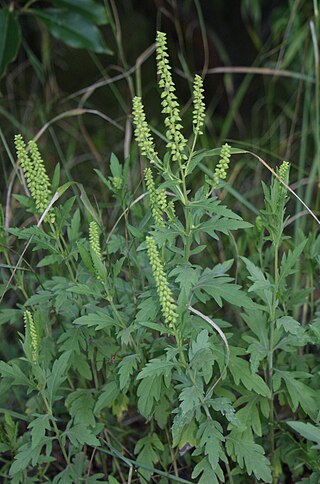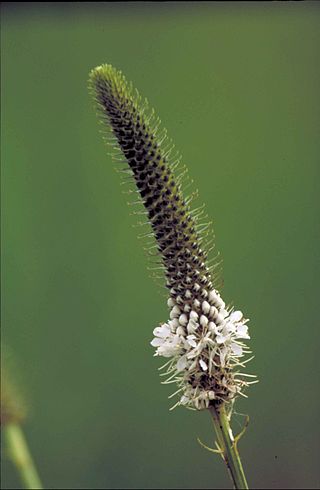
Ragweeds are flowering plants in the genus Ambrosia in the aster family, Asteraceae. They are distributed in the tropical and subtropical regions of the Americas, especially North America, where the origin and center of diversity of the genus are in the southwestern United States and northwestern Mexico. Several species have been introduced to the Old World and some have naturalized and have become invasive species. In Europe, this spread is expected to continue, due to ongoing climate change.

Sphaeralcea is a genus of flowering plants in the mallow family (Malvaceae). There are about 40-60 species, including annuals, perennials, and shrubs. Most originate in the drier regions of North America, with some known from South America. They are commonly known as globemallows, globe mallows, false mallows or falsemallows. The name of the genus is derived from the Greek words σφαῖρα (sphaira), meaning "sphere," and αλκεα (alkea), meaning "mallow."

Antennaria is a genus of dioecious perennial herbs in the family Asteraceae, native to temperate regions of the Northern Hemisphere, with a few species in temperate southern South America; the highest species diversity is in North America. Common names include catsfoot or cat's-foot, pussytoes and everlasting.

Cardamine is a large genus of flowering plants in the mustard family, Brassicaceae, known as bittercresses and toothworts. It contains more than 200 species of annuals and perennials. Species in this genus can be found in diverse habitats worldwide, except the Antarctic. The name Cardamine is derived from the Greek kardaminē, water cress, from kardamon, pepper grass.

Draba is a large genus of flowering plants in the family Brassicaceae, commonly known as whitlow-grasses.

Packera is a genus of about 75 species of plants in the daisy family, Asteraceae. Most species are commonly called ragworts or grounsels. Its members were previously included in the genus Senecio, but were moved to a different genus based on chromosome numbers, a variety of morphological characters, and molecular phylogenetic evidence.

Dalea is a genus of flowering plants in the legume family, Fabaceae. Members of the genus are commonly known as prairie clover or indigo bush. Its name honors English apothecary Samuel Dale (1659–1739). They are native to the Western hemisphere, where they are distributed from Canada to Argentina. Nearly half of the known species are endemic to Mexico. Two species of Dalea have been considered for rangeland restoration.

Brewerimitella breweri is a species of flowering plant in the saxifrage family, known by the synonyms Mitella breweri and Pectiantia breweri and by the common names Brewer's mitrewort and Brewer's bishop's cap. It is native to western North America from British Columbia to central California and Nevada, where it grows in moist meadows, woods, and mountain forests.

Brewerimitella ovalis is a species of flowering plant in the saxifrage family known by the common names coastal miterwort and oval-leaf miterwort. It is native to western North America from southwestern British Columbia, including Vancouver Island, to northern California as far south as Marin County. It grows in moist, shady habitat, such as coastal forests and streambanks.

Pectiantia pentandra is a species of flowering plant in the Saxifrage Family (Saxifragaceae), known by the common names fivestamen miterwort or five-point bishop's cap.

Ozomelis is a small genus of flowering plants in the family Saxifragaceae, native to Alaska, western Canada and the western United States. It is probably sister to Heuchera.
Brewerimitella is a genus of flowering plants in the saxifrage family, Saxifragaceae. It includes two species of perennials native to western North America, ranging from California and Nevada to Montana, Alberta, and British Columbia.











